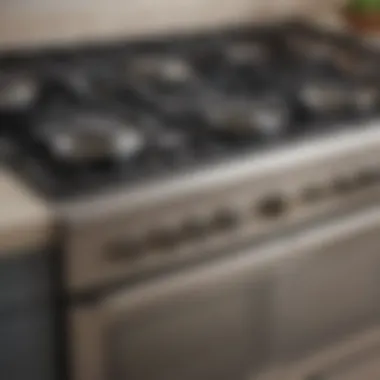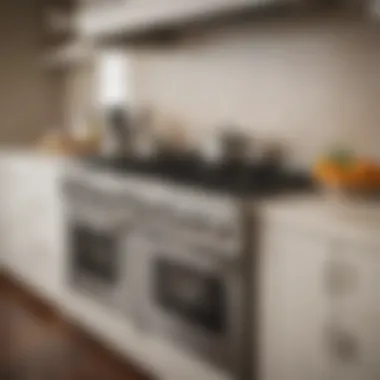Exploring Top Knob Gas Ranges: Features and Benefits


Intro
The design of these gas ranges is often minimalist, reflecting modern kitchen aesthetics. Their arrangement also aids in efficient kitchen organization and workflow.
In this exploration, we will discuss several aspects of top knob gas ranges, including their construction, advantages, potential challenges, installation advice, and maintenance tips.
While this guide aims to inform and educate, it is equally meant to assist those looking to elevate their cooking experience with the right appliance. Preparing high-quality meals becomes more manageable when equipped with tools designed for best practices in a kitchen environment.
Prologue to Gas Ranges
Gas ranges are essential appliances in many kitchens, combining efficiency with cooking versatility. Understanding the nuances of gas ranges allows cooks and food enthusiasts to make informed choices that enhance their culinary experiences.
In this article, we will explore the significance of gas ranges with knobs positioned on top. This section sets the stage for further discussions about different types of gas ranges and what makes the top-mounted knobs advantageous in ensuring easier access and improved safety.
What is a Gas Range?
A gas range is a cooking appliance that uses gas as its fuel source, providing direct heat for cooking methods like boiling, frying, and baking. Unlike electric ranges, gas ranges allow for instant temperature adjustments, making them popular among professional chefs and home cooks alike. They often include various features, such as sealed burners and oven sizes, accommodating different cooking preferences.
Types of Gas Ranges
When delving into the diverse options of gas ranges, it’s helpful to categorize them into three types: freestanding, slide-in, and built-in gas ranges. Each type serves unique user needs and cooking styles.
Freestanding Gas Ranges
Freestanding gas ranges are versatile fixtures in kitchens, often found in residential settings. Their notable feature is the ability to be placed anywhere, as they have finished sides. This enhances their flexibility in designing kitchen layouts. Their popularity also stems from affordability and ease of installation. These ranges typically offer multiple burners and spacious ovens, suitable for both daily meals and larger family gatherings.
Slide-in Gas Ranges
Slide-in gas ranges, unlike their freestanding counterparts, are built to fit snugly between countertops. Their sleek appearance can enhance any kitchen's aesthetics while adding a touch of modernity. One significant advantage is the seamless integration with cabinetry, which eliminates visible gaps. This type generally features controls on the front, making access easier without reaching over burners. They appeal to those who prioritize style and function.
Built-in Gas Ranges
Built-in gas ranges are designed for permanent installation within a kitchen cabinetry system. This specific aspect allows for a customized kitchen layout. They typically incorporate advanced technology and larger capacities, making them ideal for serious cooks. However, their installation can be more demanding, often requiring professional help. This is why choosing wall ovens paired with built-in ranges has become a common practice.
By diving into the options available, those interested in gas ranges can understand better which setup aligns most with their kitchen requirements. The rise in popularity of gas ranges showcases a general shift toward enhancing culinary experiences while ensuring efficiency in the kitchen.
Overview of Knob Placement
The arrangement of knobs on a gas range can determine not only the appliance's functionality but also its ease of use and safety. Understanding the specifics of knob placement contributes to a more pragmatic evaluation of gas ranges. Particularly, knobs on top of the appliance offer a different dynamic than other positioning styles. This section focuses on the crucial aspects that come with top-mounted knobs, their design essence, and the advantages they bestow upon the user.
Knobs on Top: Functionality and Design
Placing knobs on the top of a gas range presents several functional benefits. First, it allows for enhanced visibility and accessibility, ensuring users can clearly see settings while cooking. This simple change often prevents unintended adjustments and safety risks during meal preparation. With knobs in this position, home chefs do not need to lean over hot pans or pots, making the entire cooking process safer, more convenient, and more fluid.
Design-wise, many modern gas ranges with top-mounted knobs tend to feature a sleek, minimalist aesthetic that elevates kitchen decor. The knobs themselves are often rotary and come equipped with distinct markings and lights, making adjustments intuitive. Manufacturers focus on usability, where concerns of clutter on the stove surface are minimized. Beyond temporary safety, design impacts the overall user experience significantly, contributing to an efficient kitchen workflow.
Comparison to Other Knob Positions
Several other configurations exist in the market, including front-mounted and side-mounted knobs. Each presents unique characteristics impacting the day-to-day experience of the user.
Front-mounted Knobs


Having knobs at the front of a range Naturally provides easy access. Many home cooks prefer this layout for its straightforward design. Front-mounted knobs enable changes to be made quickly without reaching over food or along a hot surface.
A key characteristic of front-mounted knobs is their ergonomics. They require minimal hand movement, working within an easily accessible boundary, especially when baking or cooking intricate dishes. However, there are disadvantages. Potential spills from the cooktop may lead to unintended damage or wear, affecting long-term lifespan since spills commonly run toward the knobs.
Side-mounted Knobs
Positioned along the sides of the appliance, side-mounted knobs justify separate advantages. This setup is often appreciated in professional contexts, where speed and urgent efficiency matter. It permits uninterrupted workspace for large pots or cookware, keeping surfaces clearer. Additionally, it can lead to safer practices by reducing chances of accidental adjustment during regular cooking tasks.
Yet, this design can limit visibility. If users stand in front of the appliance, it may become cumbersome to read the corresponding indications on the knobs, leading to frequent confusion. Thus creating awareness of each knob’s setting poses a challenge.
Advantages of Gas Ranges with Knobs on Top
In this section, we will discuss the advantages of gas ranges with knobs positioned on the top. This design choice is becoming increasingly popular in modern kitchens, largely due to its functional benefits and safety features.
Improved Accessibility
Gas ranges with knobs on top offer significant convenience for users. These knobs are placed within easy reach at the back of the cooktop, enabling cooks to adjust flames without leaning over hot surfaces. This is especially beneficial when using larger pots or when cooking multiple items at once. Users can easily monitor what's cooking and adjust heat levels swiftly, ensuring efficient meal preparation.
In homes with children or pets, having knobs on top allows for better safety measures, as they are less likely to be tampered with compared to side or front-mounted knobs. Placement at the back reduces the risk of accidental activations that might result in burns or fires. Some manufacturers even incorporate childproof features into these knobs, enhancing peace of mind for parents.
Here are some considerations regarding accessibility:
- Clear Sight Lines: Users can see the state of their cooking without any obstruction.
- Ergonomic Design: Knobs placed on top are typically more aligned with natural hand movements, making adjustments feel intuitive.
- Space-Efficient: The absence of side mounted controls allows for greater use of countertop space.
Enhanced Safety Features
Safety is a paramount consideration when selecting kitchen appliances, and gas ranges with knobs on top include many attributes that enhance user safety. The primary advantages revolve around reducing risks when operating the appliance.
- Reduced Burn Risk: With knobs on top, the distance between the cooking surface and the knobs minimizes the risk of users accidentally hitting knobs while reaching for pots, a common issue with front-mounted designs.
- Easier to Shield from Heat: Knobs mounted in this position can be designed to withstand heat better as they are further from direct flames, thereby extending their life and reliability.
- Locking Mechanisms: Many ranges incorporate child lock features on top-mounted knobs, an essential function for maintaining safety in households with young ones.
In emergency situations, quick access to the knobs is crucial. Users can easily turn off burners to snuff out flame or gas leaks, quickly assuming control over the cooking environment. With these enhanced features combined with user-friendly accessibility, the experience of using a top-knob gas range becomes both pleasant and safer.
In comparison to other knob positions, top-mounted knobs provide an overall information-centric and accessible experience where safety coexists naturally with functionality.
Key Features of Top Knob Gas Ranges
Gas ranges with knobs on top present unique features that distinguish them from other cooking appliances. These attributes enhance usability, aesthetics, and overall cooking experience. Understanding these key features helps consumers make informed choices that meet their culinary needs.
Stainless Steel vs.
Other Materials
When selecting a gas range with top knobs, the choice of materials becomes significant. Stainless steel is a popular choice for both durability and appearance. Product such as the Frigidaire Professional Stainless Steel Gas Range often showcase a polished finish that adds a modern touch to the kitchen. This material is resistant to rust and corrosion.
In comparison, enamel-coated steel can be easier to clean. However, it is more prone to chipping and discoloration over time. Ranges made of cast iron provide excellent heat retention but may need more upkeep to avoid rust. Built-in features, like integrated griddle plates crafted from stainless steel, further enhance versatility.
Ultimately, it depends on user preference and cooking style. It is important to consider how the material's durability impacts long-term use.
Oven Capacity and Performance
The size and performance of the oven are critical for any gas range. Top knob gas ranges offer varying oven capacities, catering to different sizes of households and cooking needs. For example, an oven with a 5.3 cubic feet capacity can support large family meals. Often optimized for even heating, products like the GE Profile Gas Range provide consistent results. Also, features like warming drawers improve usability, making multi-course meals more feasible.


When examining performance, consider aspects such as heat distribution and rise time. Some brands, such as Wolf, equip their models with advanced convection technology. This promotes even baking and cooking. Performance checks are also essential. Keeping up with checks can extend longevity and effectiveness.
In summary, evaluating oven capacity along with the performance helps identify the right gas range to fulfill cooking goals.
Installation Considerations
Installing a gas range with knobs on top require specific consideration for optimal use and safety. Proper installation is essential to ensure safe operation as well as optimal performance. A firm understanding of installation criteria can facilitate better choice and maintenance of the appliance over time.
Space Requirements
Before proceeding with an installation, evaluating space is crucial. The suitable area should not only accommodate the unit itself but also allow for comfortable use. Typically, the required dimensions will vary with the brand and model, but a standard width ranges between 30 to 36 inches.
- Ensure there is enough clearance around the gas range for adequate movement while cooking.
- Consider including additional space if you plan on using larger pots or pans.
- Room for oven door swings must also be factored in. A clearance of at least 15 inches to neighboring obstacles will enhance usability.
Also, assess the height and depth of the unit. Most models require a depth that deviates between 25 to 30 inches. Additionally, watching out for countertop height may assist in seamless integration into the kitchen layout.
Maintenance of Gas Ranges with Top Knobs
Proper maintenance of gas ranges with knobs on top is essential for the longevity and reliability of the appliance. Regular care ensures that it operates efficiently, enhances cooking safety, and maintains a clean cooking environment. Users can benefit significantly from understanding the specific elements that define effective maintenance here. This section covers cleaning, performance checks, and other helpful practices that align with maintaining your gas range in top condition.
Cleaning Guidelines for Top Knobs
Cleaning gas range knobs is a straightforward task, yet it can greatly affect functionality and visual appeal. Knobs may accumulate grease, dirt, and food particles, leading to a less attractive cooking surface. To effectively clean them, follow these steps:
- Turn Off the Range: Safty first. Ensure that the gas is completely off before starting any cleaning.
- Remove the Knobs: Depending on the design, many knobs simply pull off. Look for a way to gently detach them for more thorough cleaning.
- Soak in Soapy Water: Fill a bowl with warm, soapy water and let the knobs soak. Common dish soap works well.
- Scrub Gently: Use a sponge or soft brush to scrub away any stubborn grime without scratching the surface.
- Wipe the Base: While the knobs soak, use a damp cloth to wipe the area where the knobs fit. Avoid heavy chemicals as they might damage the finish.
- Dry Thoroughly: After rinsing the knobs, dry them with a towel to prevent water spots before reattaching.
- Reattach the Knobs: Once fully dry, reinsert the knobs onto the gas range. Make sure they fit securely.
By adhering to these guidelines, users can maintain a clean and functional cooking space, reducing the likelihood of food contamination or mechanical issues with the knobs.
Performance Checks
Regular performance checks can help identify any potential issues before they become problematic. Ensuring that a gas range is in optimal working condition is crucial. Here are some key checks to incorporate into your maintenance routine:
- Inspect Knob Operation: Test each knob for smooth movement. If knobs come loose or stiff, record this for further attention.
- Monitor Ignition System: Flame quality is an excellent indicator of performance. Check for steady blue flames, which suggest optimal burner performance. A fluctuating or yellow flame may indicate issues with gas flow that need resolving.
- Check for Leaks: Periodically, examine all gas connections for any signs of leaks. You can do this by applying a soap solution to the connections; if bubbles form, a leak is present. Turn off the gas and contact a professional.
- Clean Burners: Grit and buildup on burners can impede performance. Make sure to remove and clean them regularly.
- Evaluate Gas Supply Pressure: If cooking functions seem disrupted, improper gas pressure could be the cause. A technician can assess this part.
Incorporating these checks periodically ensures that your gas range remains efficient and safe, promoting a good cooking experience in the kitchen.
"Remember, diligent maintenance not only saves on repair costs but also ensures a refined cooking environment you'll enjoy every day."
Common Issues and Troubleshooting
When it comes to gas ranges with knobs on top, being aware of common issues and their solutions is essential. This section aims to elucidate critical troubleshooting aspects. Recognizing potential problems can prevent cooking delays, improve safety, and enhance overall performance of the range.
Gas Leak Detection
Gas leaks present a serious hazard in any kitchen. Therefore, effective detection is vital. Signs of a gas leak include a noticeable odor resembling rotten eggs, hissing sounds, or a fluctuating flame.
To ensure safety, consider the following checks for gas leaks:
- Odor Check: If you smell gas, do not ignore it. It is necessary to shut off the gas supply immediately and ventilate the area.
- Soap Test: Mix soap with water and apply the solution to gas connections. If bubbles form, this indicates a leak.
- Use a Detector: Investing in a gas detector can provide a safe measure against leaks. Modern detectors can sound an alarm when gas levels become unsafe.
In case of detection, it’s critical to contact a professional for repair. Avoid using electrical devices during a potential leak; this can create sparks and ignite the gas.


Knob Malfunctions
Knob malfunctions are somewhat common in gas ranges. These issues can arise due to wear and tear, improper handling, or hardware defects. Symptoms of knob malfunctions include non-responsive knobs or difficulty in turning them.
Here are some troubleshooting tips:
- Inspecting the Knobs: Remove the knobs gently and check for debris or grease build-up underneath. Cleaning can resolve many small issues.
- Lubrication: Sometimes, reversal of functionality occurs due to lack of lubrication. A small amount of food-safe oil can restore smooth movement.
- Replacement: If knobs are damaged, replacements typically can be bought from the original manufacturer or appliance repair services.
- Check Inner Mechanisms: If knobs still do not operate correctly, it may be necessary to investigate further. Look into the inner control mechanism for complications. If not familiar with repairs, seek a professional’s help.
Gas ranges require attention to detail and regular check-ups. Understand these common issues to enhance safety and usability.
Understanding common issues is critical for efficient and safe cooking. Regular maintenance, inspection, and a proactive approach lead to a competent cooking experience.
Cost and Value Assessment
Evaluating cost and value is a crucial part of selecting a gas range that includes knobs on top. The pricing structure often reflects the features, quality, and longevity of the appliance. For buyers, understanding how the pricing correlates with the range's essential features ensures an informed decision.
While shopping, potential users should consider not just the initial price but also the functional features that come along with gas ranges designed with top-mounted knobs. Gas ranges can vary significantly in featured add-ons like smart technology, self-cleaning options, or warranties. Assessing the value can provide insights that save money in the long run.
Key factors to contemplate in relation to cost and value include:
- The overhead appliance cost associated with top knobs.
- Safety features such as burners that automatically turn off.
- Energy efficiency ratings obtanined from gas use compared to electric ranges.
- Accessibility, which is a significant aspect of user convenience.
When one evaluates cost against features, it shines a light on the efficiency, comfort, and creative cooking possibilities that the appliance brings to home kitchens.
Evaluating Price vs.
Features
The price vs. features evaluation helps define if a gas range aligns with the buyer's cooking style and requirements. For example, consider the essential features like burner output, build quality, and additional modes. High-powered burners may have a higher cost but tend to offer more precise temperature control.
Important features to examine may includ:
- Number of burners
- Special settings like rapid boil or warming zones
- Material quality, such as stainless steel or enamel finishes
Buyers should also take into account brand reputation and customer reviews. Keep checking varied sellers' offers, as some might include extended warranties or deliver outstanding customer support experiences.
Consider this guideline: While buying cheaper ranges can be tempting, they may come with limitations that hamper an optimal cooking expereience. Over time, those issues could increase operational costs in repairs or replacements, sowing seeds of potential regret.
Long-term Savings with Gas Appliances
Over a period of use, gas appliances frequently promise long-term savings not only in operational efficiency but also in maintenance. Natural gas tends to be more inexpensive compared to electricity, which overall reduces utility bills for a household. Hence, once installed, gas ranges can make for more economical choices over correspounding electric models.
Key approaches to maintain long-term savings feature:
- Understand the energy consumption of the specific gas range model you're acquiring
- Use the oven efficiently by cooking multiple dishes simultaneously whenever feasible
- Benefit from more direct flame cooking, which may save time and fuel compared with slower electric alternatives around
In summary, assessing cost against feature set along with its long-term savings reveals a multifaceted decision-making experience. A thorough understanding will ultimately enable buyers to choose a gas range designed with their highest specs in mind for impressive cooking outcomes through years.
Epilogue
In this article, we explored the concept of gas ranges with knobs on top, emphasizing their role in improving kitchen efficiency and safety. The arrangement of the knobs provides several advantages, notably accessibility and ease of maintenance. Unlike traditional placements, top-mounted knobs allow for greater space savings and a cleaner counter appearance, which can lead to more enjoyable cooking experiences.
Gas ranges equipped with top knobs also foster enhanced safety features. For families with children, this design minimizes the risk of accidental flare-ups and tampering. As we discussed, safety in the kitchen is paramount, and having element controls placed away from the stove’s main surface can make a significant difference.
Greater convenience is essential when evaluating these appliances. Home chefs and professional cooks alike benefit from easy gear shifts when working with multiple components of their meals. Rather than leaning over hot burners to adjust flames, users can operate safely from a standing position. This not only contributes to better posture but also reduces potential burns or injuries.
Considerations on cost are equally important. Although ranges with knobs on top might be marginally more expensive, their utilitarian benefits, notably in terms of durability and safety, present a superior return on investment over time. Homeowners will often find that features resulting in long-term benefits outweigh initial maintenance costs.
Overall, understanding the value and functionality provided by gas ranges with knobs on top serves to enhance upon existing knowledge of kitchen appliances, hereby aiding informed purchasing and user decisions. As kitchen dynamics continue to evolve, such innovations carry potential that aligns with modern cooking practices and varies lifestyle needs.







